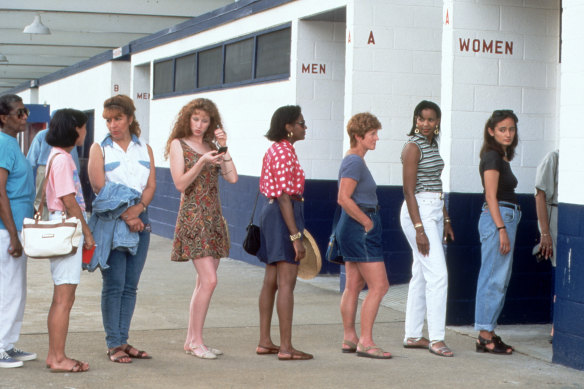This was published 1 year ago
Opinion
Had I ever expected to go viral, it would not have been because of toilets
Jamila Rizvi
ColumnistHad I ever expected to go viral, it would not have been because of toilets. Yet here we are. More than one million people have now spent more than 9000 collective hours watching a 60-second video of me explaining the inequity of floor space in public bathrooms. Were they on Instagram, I’m sure my parents would be terribly proud.
My intention had been to explain the difference between equality and equity. To communicate that because human beings have different assets, abilities and access, treating them all the same is rarely a fair thing to do. Such examples exist in just about every sphere of our lives, from workplaces to hospitals to public parks. But I was naive enough to choose toilets.

A familiar scene: women queuing for public toilets. Floor space equal to the men’s toilet does not afford women the same convenience. Credit: Getty
The inequity of public bathroom design is in the equal floor space given to men’s and women’s toilets. This is illogical when people’s usage patterns, privacy needs and accommodation are so different. Male-designated public toilets have urinals as well as cubicles, meaning more people can use the bathroom at the same time. But even when bathrooms have an equal number of stalls and no urinals, their design doesn’t account for women taking, on average, more than twice as long to use the toilet.
People using the female-designated bathrooms are more likely to have babies or children accompanying them. If there’s anything we know about offspring, it’s that they excel at slowing you down. Moreover, women have longer lifespans, which means they are more likely to be elderly or disabled and take a bit longer using the toilet.
I added to these objectively mundane points that most people who menstruate are women and they use bathrooms to change tampons and sanitary pads, not only to use the actual toilet – again, taking longer than the average bloke who walks in, uses the urinal, hopefully washes his hands, and leaves.
Did you pick it? Can you identify the colossal controversy in my not especially original explanation of how bathrooms work? Was it a rampage of women, furious and fed up with wasting years of their lives in queues during theatre intermissions and half-time at the footy? Sadly, no. It’s the phrase “people who menstruate” that caused all the fuss.
People’s concern appears to stem from differing perspectives on gender and how language should be used to accurately describe individuals’ experiences. Using the words “people who menstruate”, where previously we might have said “women”, divides the population into three distinct political camps: those who think it makes sense, those who think it’s an abomination and those who didn’t notice.
Generally, “people who menstruate” is employed for purposes of precision and inclusion. Its use ensures transgender and non-binary people feel safe and welcome in spaces where they might otherwise be trepidatious. It also challenges still-prevalent assumptions that only women menstruate and that all women menstruate.
Just as there are transgender men and non-binary people who get a period each month, there are many cisgender women who do not. Women who’ve been through menopause, women using hormonal intrauterine devices for contraception, women whose hormone production is disrupted due to chronic illness or eating disorders, women who are pregnant and women who have had hysterectomies, to name just some.
That our linguistic landscape is capable of evolution is neither new nor surprising. How we speak to and about one another shifts with developments in technology, culture, morality, propriety and identity. Without progress of this kind, I’d be greeting my neighbour with “good morrow” before remarking on the “queer” weather we’d experienced “thrice” this past week.
But we all know toilet panic isn’t really about words; it’s about fear. Fear that changing gender norms might somehow pose a danger to you personally. Or that the elevation of someone else’s right to be included means you’ll be left behind. Why else would my adding an extra few words to a sentence cause such an emotionally charged reaction among so many people?
That a matter as simple and as private as going to the toilet can trigger rage reveals the heightened anxiety about gender currently engrossing our community. There are, and will continue to be, serious debates as our understanding grows and evolves. But when it comes to language – even if we don’t wish to change our own – surely we can abide someone else changing theirs.
It is the smallest possible inconvenience to shift one’s choice of words to make anyone who falls into these varied groups of identities and experiences feel included. And it is a basic politeness, extended from speaker to audience, that says: “I recognise the diversity of who you are and what has happened in your lives, and I am grateful to you for being part of this conversation.”
Jamila Rizvi is deputy managing director at Future Women, which provides workplace gender-equality expertise and advice.
The Opinion newsletter is a weekly wrap of views that will challenge, champion and inform your own. Sign up here.